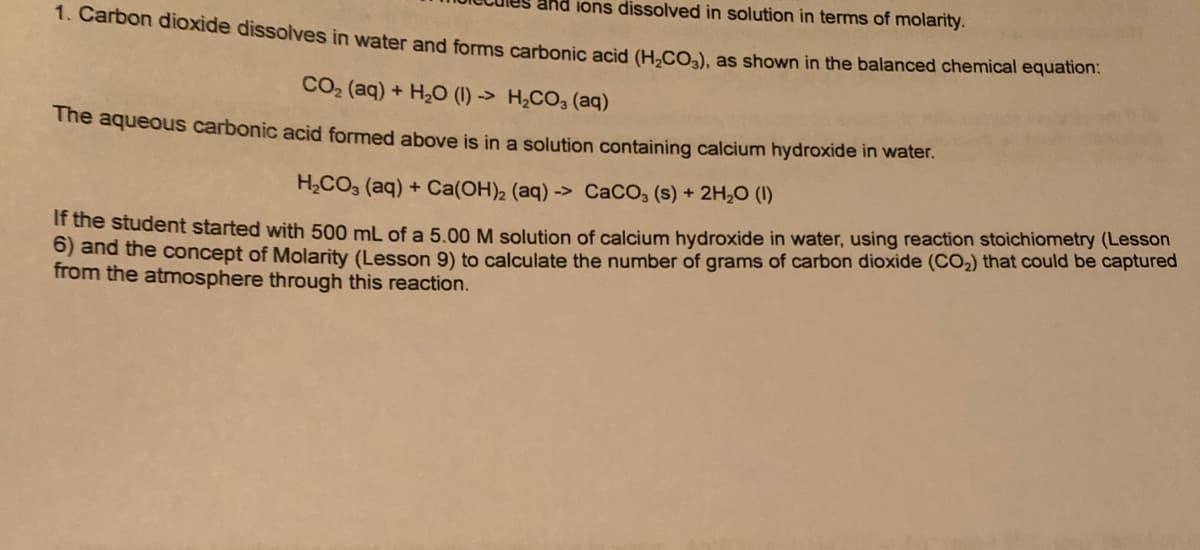acid formed above is in a solution containing calcium hydroxide in water. H,CO, (aq) + Ca(OH)2 (aq) -> CaCO, (s) + 2H,0 (1) ted with 500 mL of a 5.00M solution of calcium hydroxide in water, using reaction stoichior pt of Molarity (Lesson 9) to calculate the number of grams of carbon dioxide (CO2) that cou nere through this reaction.
acid formed above is in a solution containing calcium hydroxide in water. H,CO, (aq) + Ca(OH)2 (aq) -> CaCO, (s) + 2H,0 (1) ted with 500 mL of a 5.00M solution of calcium hydroxide in water, using reaction stoichior pt of Molarity (Lesson 9) to calculate the number of grams of carbon dioxide (CO2) that cou nere through this reaction.
Chemistry for Engineering Students
4th Edition
ISBN:9781337398909
Author:Lawrence S. Brown, Tom Holme
Publisher:Lawrence S. Brown, Tom Holme
Chapter4: Stoichiometry
Section: Chapter Questions
Problem 4.97PAE
Related questions
Question

Transcribed Image Text:and ions dissolved in solution in terms of molarity.
1. Carbon dioxide dissolves in water and forms carbonic acid (H.CO.), as shown in the balanced chemical equation.
CO2 (aq) + H2O (1) -> H,CO3 (aq)
The aqueous carbonic acid formed above is in a solution containing calcium hydroxide in water.
H,CO3 (aq) + Ca(OH)2 (aq) -> CaCO, (s) + 2H,0 (1)
If the student started with 500 mL of a 5.00 M solution of calcium hydroxide in water, using reaction stoichiometry (Lesson
O) and the concept of Molarity (Lesson 9) to calculate the number of grams of carbon dioxide (CO2) that could be captured
from the atmosphere through this reaction.
Expert Solution
This question has been solved!
Explore an expertly crafted, step-by-step solution for a thorough understanding of key concepts.
Step by step
Solved in 2 steps

Knowledge Booster
Learn more about
Need a deep-dive on the concept behind this application? Look no further. Learn more about this topic, chemistry and related others by exploring similar questions and additional content below.Recommended textbooks for you

Chemistry for Engineering Students
Chemistry
ISBN:
9781337398909
Author:
Lawrence S. Brown, Tom Holme
Publisher:
Cengage Learning

Principles of Modern Chemistry
Chemistry
ISBN:
9781305079113
Author:
David W. Oxtoby, H. Pat Gillis, Laurie J. Butler
Publisher:
Cengage Learning

Introductory Chemistry: A Foundation
Chemistry
ISBN:
9781285199030
Author:
Steven S. Zumdahl, Donald J. DeCoste
Publisher:
Cengage Learning

Chemistry for Engineering Students
Chemistry
ISBN:
9781337398909
Author:
Lawrence S. Brown, Tom Holme
Publisher:
Cengage Learning

Principles of Modern Chemistry
Chemistry
ISBN:
9781305079113
Author:
David W. Oxtoby, H. Pat Gillis, Laurie J. Butler
Publisher:
Cengage Learning

Introductory Chemistry: A Foundation
Chemistry
ISBN:
9781285199030
Author:
Steven S. Zumdahl, Donald J. DeCoste
Publisher:
Cengage Learning

Introductory Chemistry: A Foundation
Chemistry
ISBN:
9781337399425
Author:
Steven S. Zumdahl, Donald J. DeCoste
Publisher:
Cengage Learning

Chemistry
Chemistry
ISBN:
9781305957404
Author:
Steven S. Zumdahl, Susan A. Zumdahl, Donald J. DeCoste
Publisher:
Cengage Learning

Chemistry: An Atoms First Approach
Chemistry
ISBN:
9781305079243
Author:
Steven S. Zumdahl, Susan A. Zumdahl
Publisher:
Cengage Learning